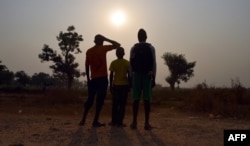The World Health Organization and nine other organizations Tuesday launched a package of measures that they said could dramatically reduce violence against children.
A new partnership and fund will promote these strategies in an effort to make reducing violence a public priority and a collective responsibility. Through the Global Partnership to End Violence Against Children, governments, foundations, civil society groups, academia and the private sector can pool resources and expertise to make progress toward these goals.
The WHO, citing statistics from the U.S. Centers for Disease Control and Prevention, said as many as 1 billion children around the world had experienced physical, sexual, or psychological violence in the past year.
According to other research quoted by the CDC, it's estimated that one in four children worldwide suffers physical abuse, and nearly one in five girls and one in 13 men and boys are victims of sexual abuse.
Alexander Butchart, WHO coordinator for the prevention of violence, said the consequences of this kind of violence are vast but unappreciated.
“What we get to see is the tip of the iceberg, in the shape of death,” he said.
For instance, he noted that homicide was among the top five causes of death in adolescents and ranked as No. 1 or No. 2 in some regions or countries.
In addition, he said, violence against children can cause brain and internal injuries, burns and lacerations “in hundreds of millions of cases.”
Butchart said “violence against kids often can lead to mental health problems like depression and anxiety. It also can lead to alcohol and drug abuse, smoking and unsafe sex.“
These dangerous behaviors, he said, “put children at much greater risk later of developing stroke, cancer, diabetes, liver disease, HIV/AIDS, et cetera.”
Christopher Mikton, WHO technical officer for prevention of violence, said many studies have documented the serious, long-term health consequences of violence against children.
“Some of the better studies have shown, for example, that if you eliminated violence against children and other serious childhood adversities, you would reduce the main mental disorders in the world by 30 percent," he said.
One study in Eastern Europe, he said, indicated that eliminating harmful childhood experiences would reduce smoking by 22 percent, problem drinking by 51 percent and suicide attempts by 83 percent.
“So I think all these figures really show the really serious consequences, and the important impact the implementation of these strategies could have on health in the longer term,” he said.
Participating groups
The package of strategies, known as INSPIRE, was jointly produced by the WHO, the CDC, UNICEF, End Violence Against Children, the Pan American Health Organization, the U.S. President's Emergency Plan for AIDS Relief , Together for Girls, the U.N. Office on Drugs and Crime, the U.S. Agency for International Development, and the World Bank.
Each letter of INSPIRE stands for one of the strategies. Buchart said all have been tested and have shown “that much of this violence against children can be prevented through measures that address the underlying causes.”
For example, he said, ‘I’ stands for implementation and enforcement of laws, such as limiting access by young people to firearms and other weapons. He said this had shown good results in South Africa, which has succeeded in reducing deaths by thousands over a five-year period.
“ 'N’ stands for norms and values change,” he said. “There are some success stories from parts of Africa where community mobilization programs have focused on encouraging men and women to use nonviolent forms of resolving conflict within the home.” He said this had been shown to reduce children’s witnessing of domestic violence, which in turn can reduce the likelihood that they will use such violence themselves.
Other strategies in the INSPIRE package call for creating safe environments, encouraging parent and caregiver support, strengthening incomes, providing treatment programs for juvenile offenders, and establishing safe school environments.
The Fund to End Violence Against Children will provide financial support to programs that accelerate action in these areas.









